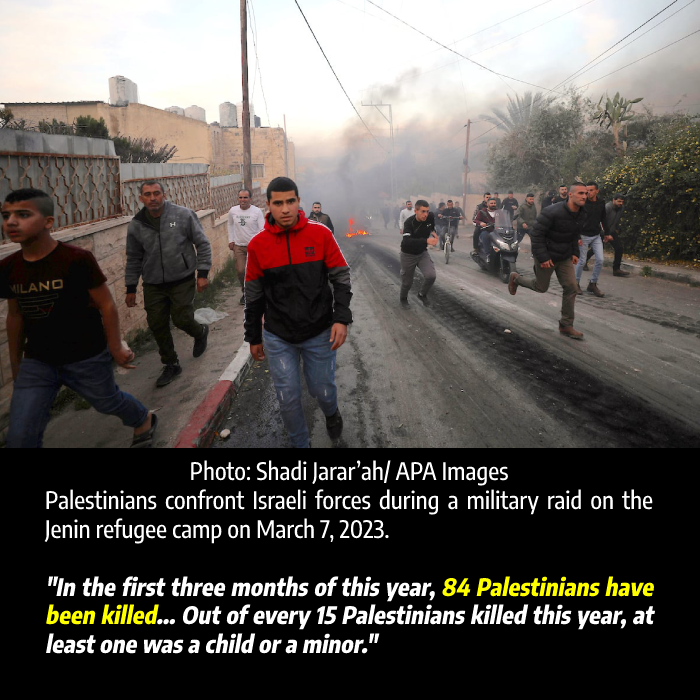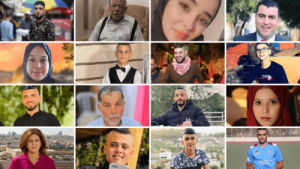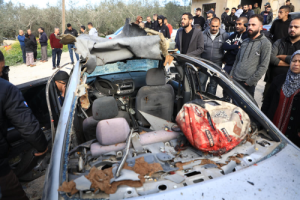By Mariam Barghouti.

Every day in Palestine, the number of deaths rises. Last year, the most deadly since the UN began documenting in 2005, more than 231 Palestinians were killed, 180 in the West Bank alone.
READ: 231 Palestinians were killed in 2022. These are their stories.

2022 was the deadliest year for Palestinians living under Israeli occupation in decades. We kept a record of all those who were killed by Israeli state and settler violence. These are their names, faces, and stories.
In the first three months of this year, 84 Palestinians have been killed. That means the number of those killed between January 2 and March 14 of this year equals 47% of Palestinians killed in what was deemed our most deadly year. Out of every 15 Palestinians killed this year, at least one was a child or a minor.
As a small team, we struggle to cover every killing in addition to everything else in motion. This is partly because we are human and struggle to cover the intensity and frequency of this much death. Yet it is also because I find myself stuck in the details of every story. I have heard first-hand testimonies from so many mothers, fathers, siblings, cousins, friends, and community members as they recall moments of execution. It is always surreal
More and more, I find myself crying in interviews, unable to console and yet relentlessly prodding to reveal some of the most intimate moments between lovers and strangers. Then I reflect on the amount of knowledge I collect, such as the details of the bullet shots. I printed out the list of Palestinians killed to track the details of their killing next to their names.
Abdomen, chest, chest, head, head, head, chest, head, chest, abdomen, head, head, neck, head, head, chest, abdomen, head, head, chest, entire body.
These are the locations of the fatal bullet shots that killed the first 21 Palestinians of this year. They are execution shots, sniper shots, clear shots, and direct shots. I use “entire body” to account for a death where the body was so decimated it is impossible to clearly identify a singular location of the injury.
These are the haunting details I see and wrestle with. Meanwhile, for the families I interview the corpse of their beloved is the single most haunting detail they must reconcile with and survive.
Since last year, the Israeli military and government have given the green light to a mass execution campaign. As a journalist, I find myself unable to find the correct language to explain this to our readers without risking accusations of hyperbole.
Then comes the coverage of resistance. I have met some of these fighters, interviewed them, and seen them grieve one assassination after the other. At the first funeral, their eyes swelled with tears, grieving and in pain. At the second funeral, I saw them bury each other, their spine arched more inwards, their breath tight and held in, and the only words they utter are different iterations of “we won’t be defeated.” By the third funeral, the eyes of the fighters were dry; the men left were younger, and the older men were more furious.
Their nephews, sons, and neighborhood boys are either dead, arrested, or at risk of either. You can map the killing spree across a family tree. It’s always a brother, cousin, or close childhood friend getting killed. These fighters are not a formal army. These are men and boys in jeans, sweatpants, and ski masks fighting a military invading their refugee camps. The same military that made them refugees in the first place.
The frequency of the slaughter is not the only thing escalating; so is the brutality. Sniper shots targeting the head and chest have become attacks that riddle bodies with bullets. The last extrajudicial execution, on March 11, was so brutal that journalists were asked not to share any photos out of respect for the bereaved families.
READ: Three resistance fighters killed in brutal Israeli assassination near Jenin

Israeli special forces ambushed three Palestinian resistance fighters in their car. The killing was so brutal that images of the slain fighters were asked not to be circulated out of respect.
On my list, the next 20 Palestinians killed are as follows:
Chest, head and neck, head, abdomen, upper body parts, head, head, head, abdomen, entire body, head, abdomen, abdomen, head, chest, entire body, entire body, entire body, entire body, entire body.
The next 20 are: face, chest, medical negligence, head, head, abdomen, abdomen, head, neck, head, entire body, entire body, entire body, entire body, entire body, entire body, entire body, chest, entire body, entire body, entire body.
The increase in attacks on the entire body would seem to reflect the Palestinian condition, which is seeing an extension of military abuse to all aspects of life. The rest is in the details.
Source: Palestine Letter via Mondoweiss Newsletters. 15 March 2023.